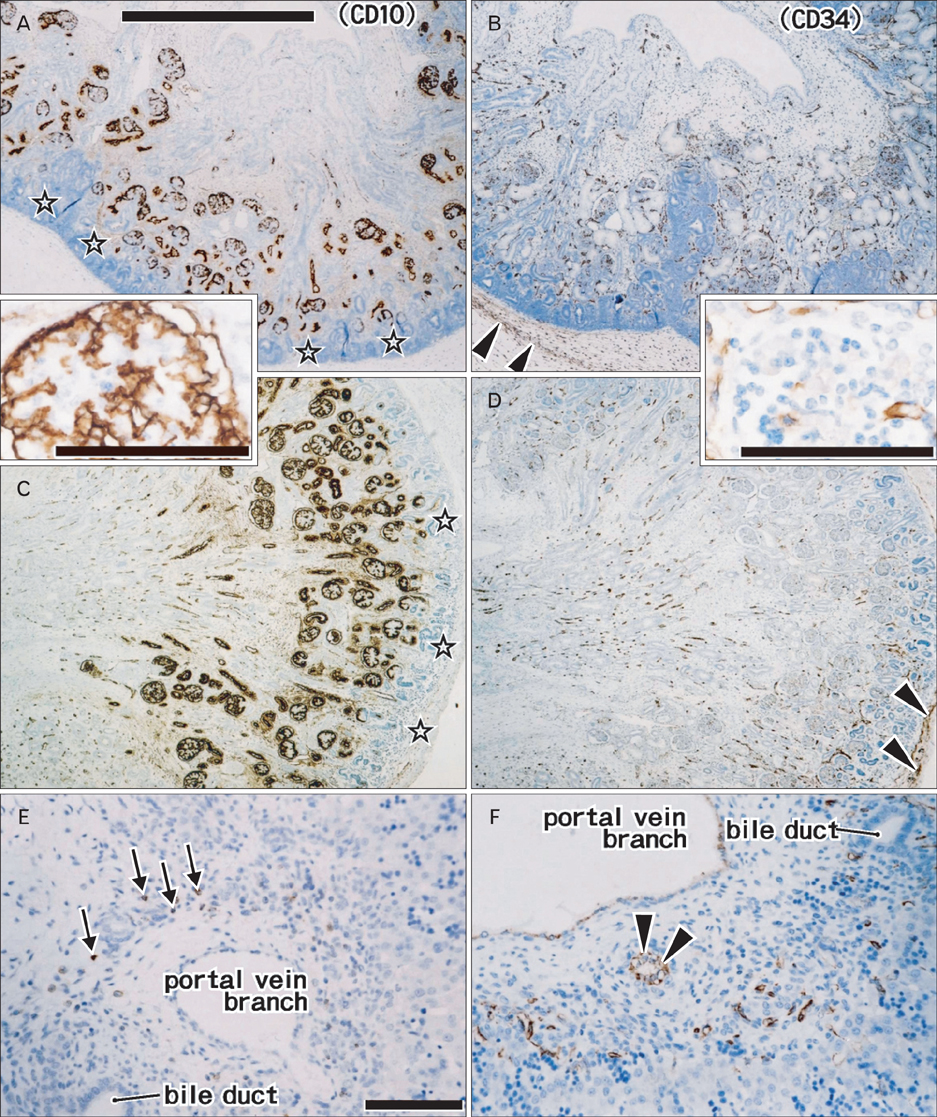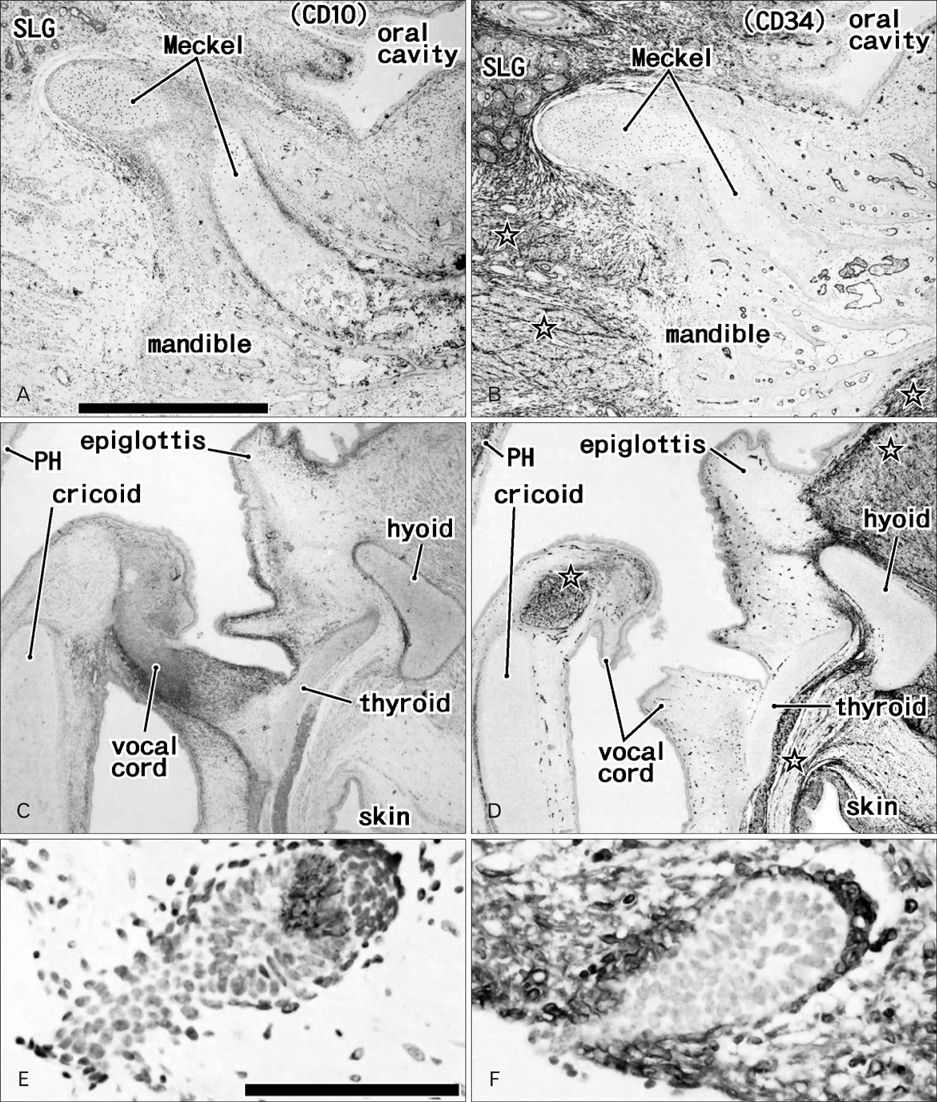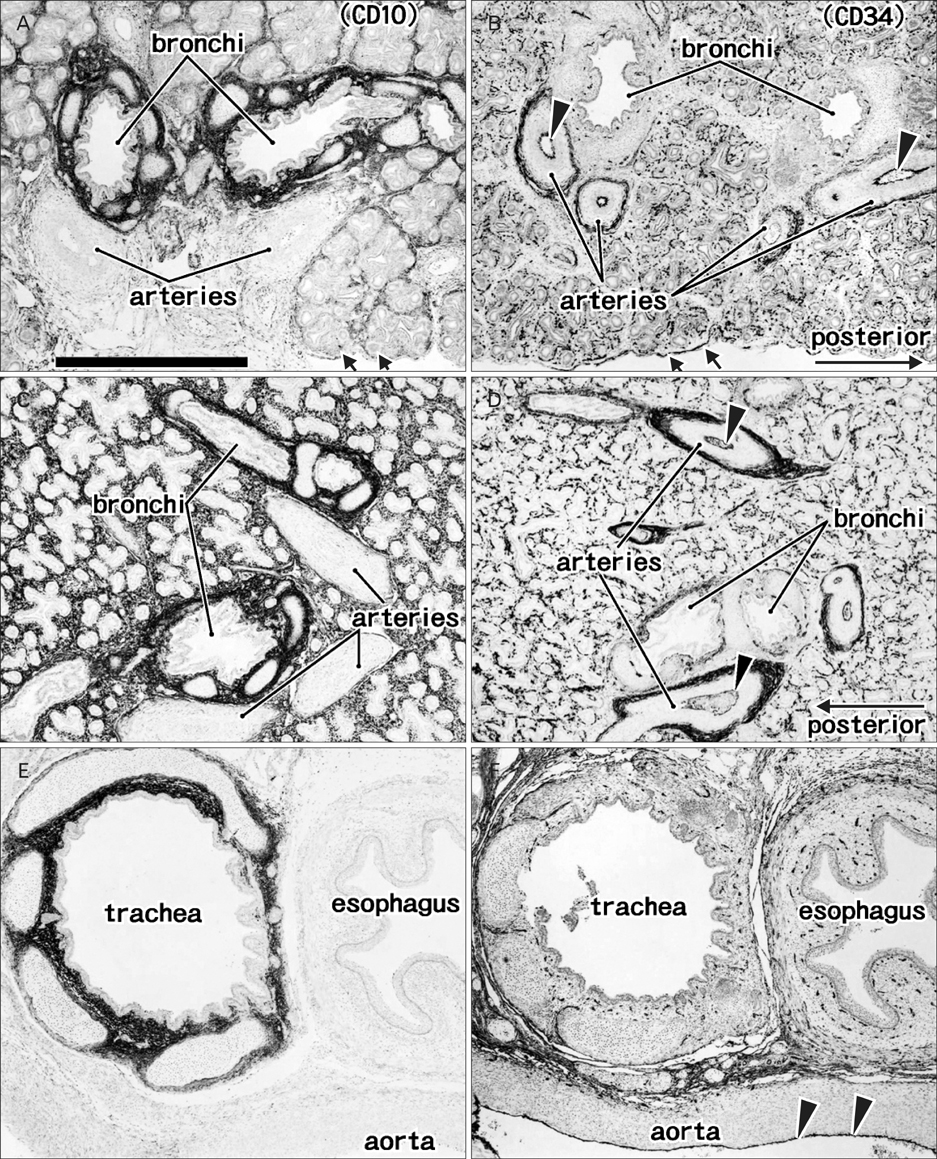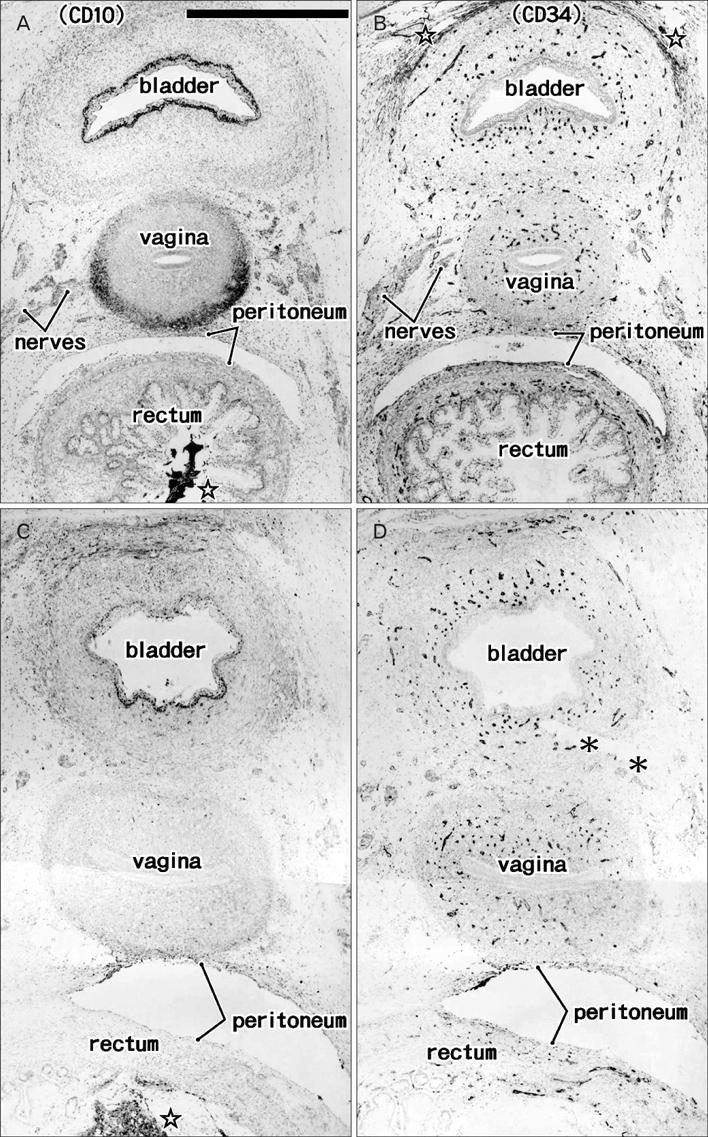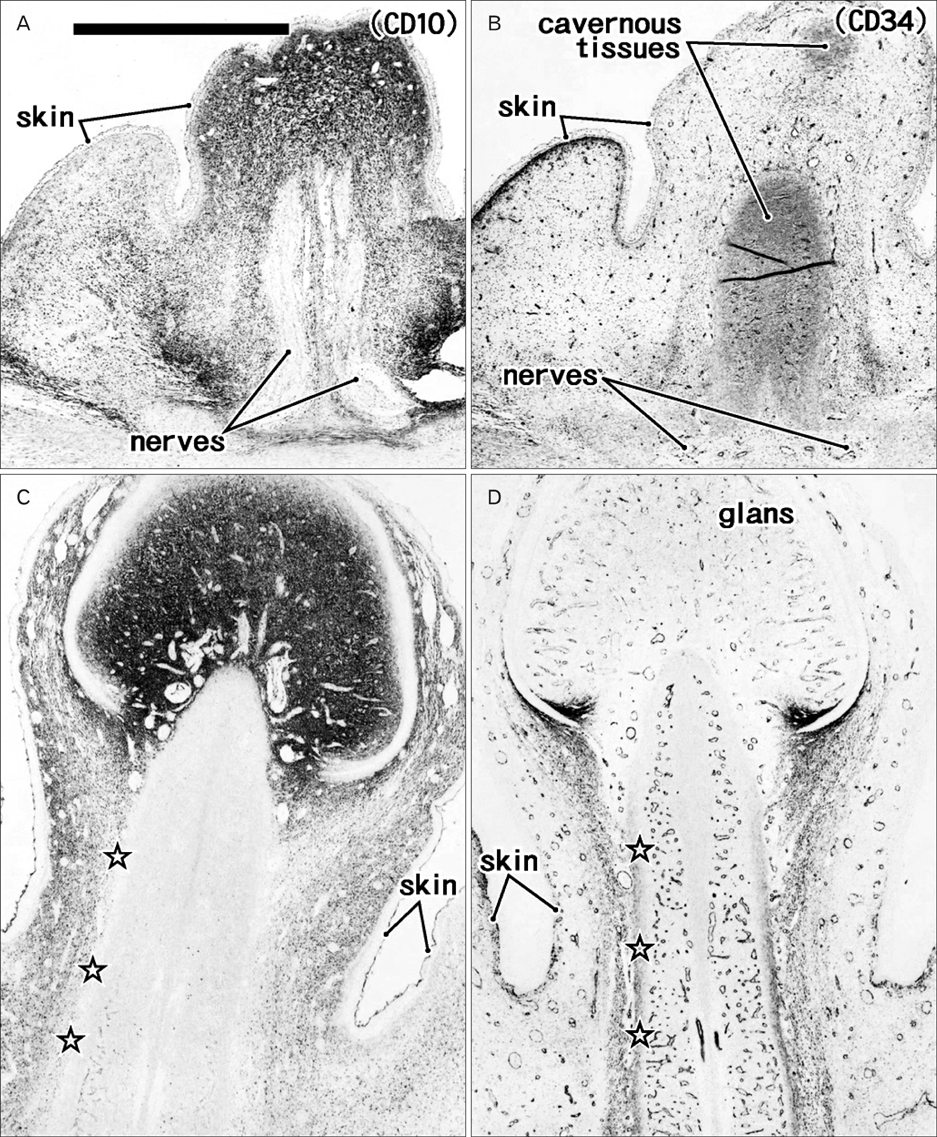Anat Cell Biol.
2014 Mar;47(1):28-39. 10.5115/acb.2014.47.1.28.
Distribution of CD10-positive epithelial and mesenchymal cells in human mid-term fetuses: a comparison with CD34 expression
- Affiliations
-
- 1Department of Anatomy, Chonbuk National University Medical School, Jeonju, Korea.
- 2Department of Surgery, Daejeon Sun Hospital, Daejeon, Korea.
- 3Department of Surgery and Biomedical Research Institute, Chonbuk National University Hospital, Chonbuk National University Medical School, Jeonju, Korea. chobh@jbnu.ac.kr
- 4Division of Otorhinolaryngology, Sendai Municipal Hospital, Sendai, Japan.
- 5Division of Internal Medicine, Iwamizawa Kojin-kai Hospital, Iwamizawa, Japan.
- KMID: 2168854
- DOI: http://doi.org/10.5115/acb.2014.47.1.28
Abstract
- CD10, a marker of immature B lymphocytes, is expressed in the developing epithelium of mammary glands, hair follicles, and renal tubules of human fetuses. To assess mesenchymal and stromal expression of CD10, we performed immunohistochemical assays in whole body sections from eight fetuses of gestational ages 15-20 weeks. In addition to expression in urinary tract and intestinal epithelium, CD10 was strongly expressed at both gestational ages in fibrous tissues surrounding the airways from the larynx to lung alveoli, in the periosteum and ossification center, and in the glans of external genitalia. CD10 was not expressed, however, in other cavernous tissues. These findings suggest that mesenchymal, in addition to epithelial cells at specific sites, are likely to express CD10. The glomeruli, alveoli, and glans are all end products of budding or outgrowth processes in the epithelium or skin. However, in contrast to the CD34 marker of stromal stem cells, CD10 was not expressed in vascular progenitor cells and in differentiated vascular endothelium. The alternating pattern of CD10 and CD34 expression suggests that these factors play different roles in cellular differentiation and proliferation of the kidneys, airway and external genitalia.
Keyword
MeSH Terms
Figure
Reference
-
1. Bárcena A, Muench MO, Galy AH, Cupp J, Roncarolo MG, Phillips JH, Spits H. Phenotypic and functional analysis of T-cell precursors in the human fetal liver and thymus: CD7 expression in the early stages of T- and myeloid-cell development. Blood. 1993; 82:3401–3414.2. Paramithiotis E, Cooper MD. Memory B lymphocytes migrate to bone marrow in humans. Proc Natl Acad Sci U S A. 1997; 94:208–212.3. D'Arena G, Musto P, Cascavilla N, Di Giorgio G, Fusilli S, Zendoli F, Carotenuto M. Flow cytometric characterization of human umbilical cord blood lymphocytes: immunophenotypic features. Haematologica. 1998; 83:197–203.4. Poblet E, Jiménez F. CD10 and CD34 in fetal and adult human hair follicles: dynamic changes in their immunohistochemical expression during embryogenesis and hair cycling. Br J Dermatol. 2008; 159:646–652.5. Bachelard-Cascales E, Chapellier M, Delay E, Pochon G, Voeltzel T, Puisieux A, Caron de Fromentel C, Maguer-Satta V. The CD10 enzyme is a key player to identify and regulate human mammary stem cells. Stem Cells. 2010; 28:1081–1088.6. Faa G, Gerosa C, Fanni D, Nemolato S, Marinelli V, Locci A, Senes G, Mais V, Van Eyken P, Iacovidou N, Monga G, Fanos V. CD10 in the developing human kidney: immunoreactivity and possible role in renal embryogenesis. J Matern Fetal Neonatal Med. 2012; 25:904–911.7. Waller EK, Huang S, Terstappen L. Changes in the growth properties of CD34+, CD38- bone marrow progenitors during human fetal development. Blood. 1995; 86:710–718.8. Abe S, Suzuki M, Cho KH, Murakami G, Cho BH, Ide Y. CD34-positive developing vessels and other structures in human fetuses: an immunohistochemical study. Surg Radiol Anat. 2011; 33:919–927.9. Katori Y, Kiyokawa H, Kawase T, Murakami G, Cho BH. CD34-positive primitive vessels and other structures in human fetuses: an immunohistochemical study. Acta Otolaryngol. 2011; 131:1086–1090.10. Chang H, Cho KH, Hayashi S, Kim JH, Abe H, Rodriguez-Vazquez JF, Murakami G. Site- and stage-dependent differences in vascular density of the human fetal brain. Childs Nerv Syst. 2014; 30:399–409.11. Yajin S, Murakami G, Takeuchi H, Hasegawa T, Kitano H. The normal configuration and interindividual differences in intramural lymphatic vessels of the esophagus. J Thorac Cardiovasc Surg. 2009; 137:1406–1414.12. Moon WS, Cho BH, Hayashi S, Kim JH, Murakami G, Fukuzawa Y, Nakano T. Cytokeratin-positive hepatocytes in the hilar region: an immunohistochemical study using livers from fetuses and elderly individuals. Ann Anat. 2011; 193:224–230.13. Gerlach JC, Over P, Turner ME, Thompson RL, Foka HG, Chen WC, Péault B, Gridelli B, Schmelzer E. Perivascular mesenchymal progenitors in human fetal and adult liver. Stem Cells Dev. 2012; 21:3258–3269.14. Kano Y, Sakurai H, Shidara J, Toida S, Yasuda H. Histopathological and immunohistochemical studies of acquired tracheobronchomalacia: an autopsy case report. ORL J Otorhinolaryngol Relat Spec. 1996; 58:288–294.15. Carden KA, Boiselle PM, Waltz DA, Ernst A. Tracheomalacia and tracheobronchomalacia in children and adults: an in-depth review. Chest. 2005; 127:984–1005.16. Invernici G, Ponti D, Corsini E, Cristini S, Frigerio S, Colombo A, Parati E, Alessandri G. Human microvascular endothelial cells from different fetal organs demonstrate organ-specific CAM expression. Exp Cell Res. 2005; 308:273–282.
- Full Text Links
- Actions
-
Cited
- CITED
-
- Close
- Share
- Similar articles
-
- Characterization of mesenchymal cells beneath cornification of the fetal epithelium and epidermis at the face: an immunohistochemical study using human fetal specimens
- Comparative Evaluation for Potential Differentiation of Endothelial Progenitor Cells and Mesenchymal Stem Cells into Endothelial-Like Cells
- Effects of Damaged Human Corneal Epithelial Cells on Differentiation of Human Mesenchymal Stem Cell
- Immunohistochemical Phenotypes of Phyllodes Tumor of the Breast
- A temporary disc-like structure at the median atlanto-axial joint in human fetuses

